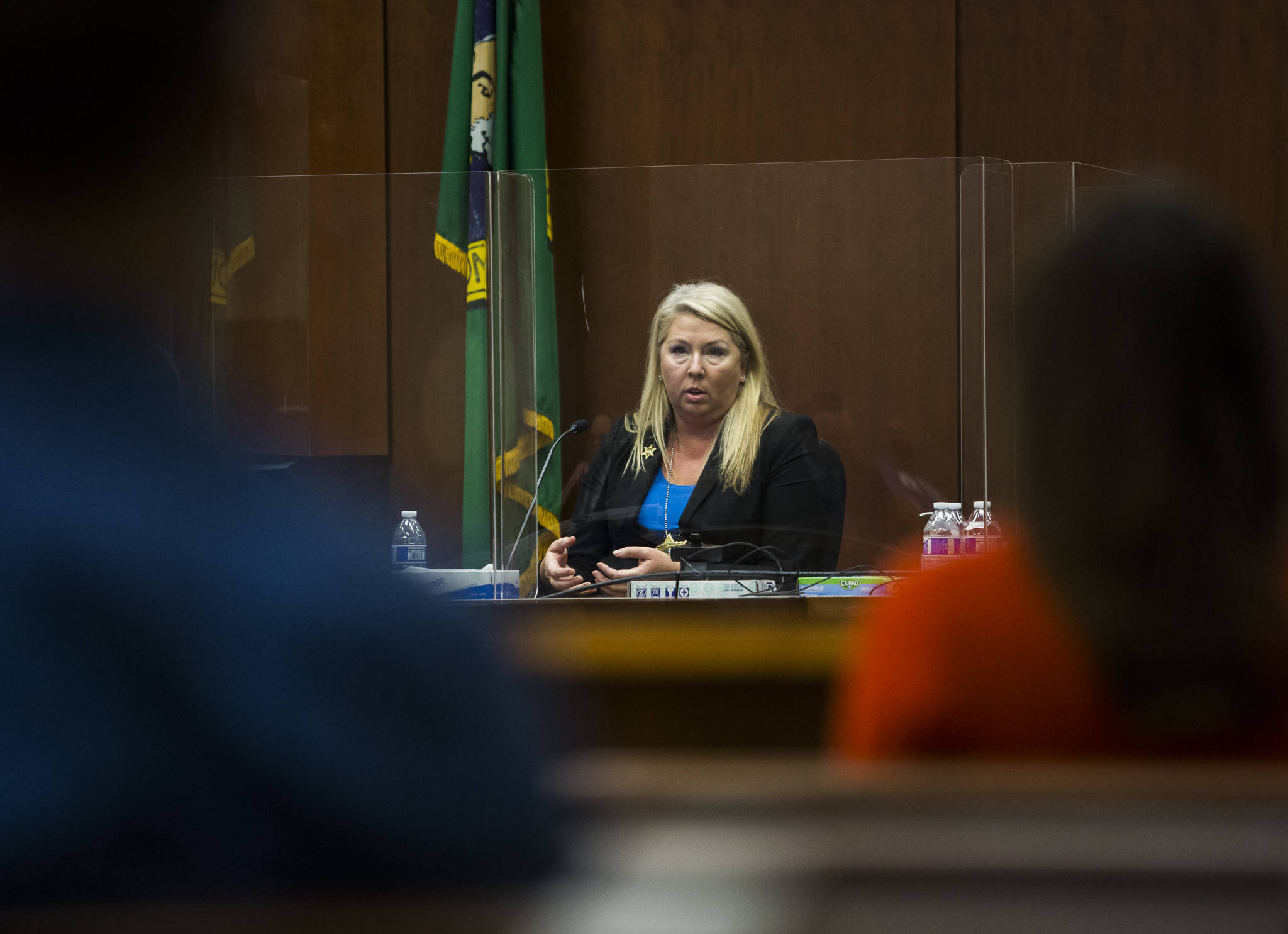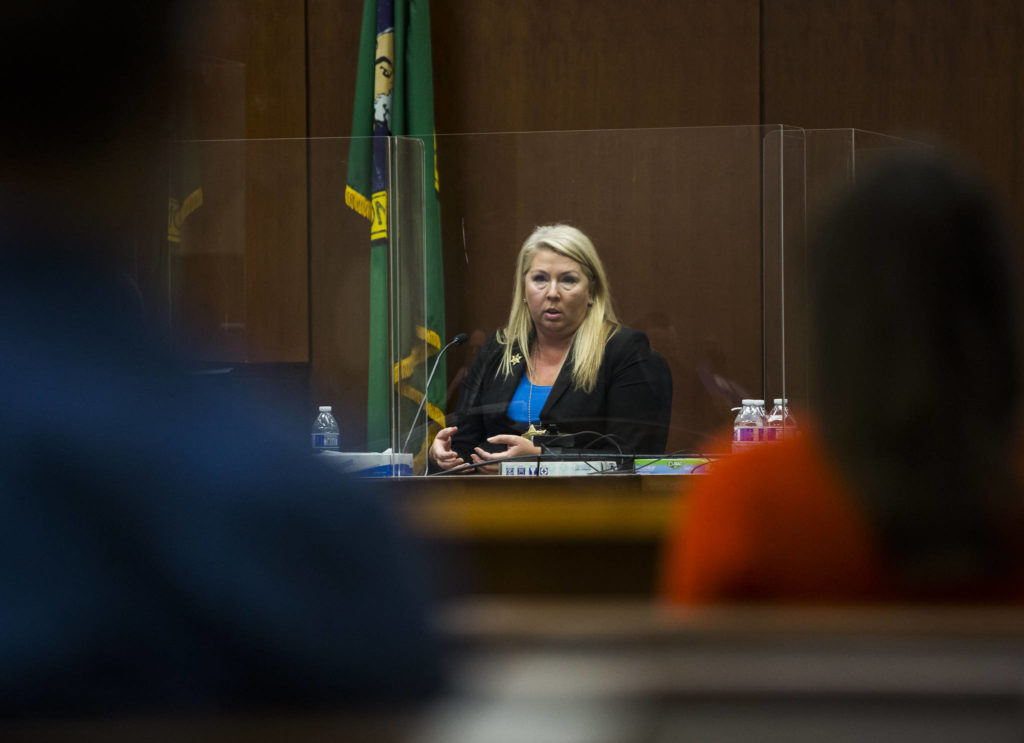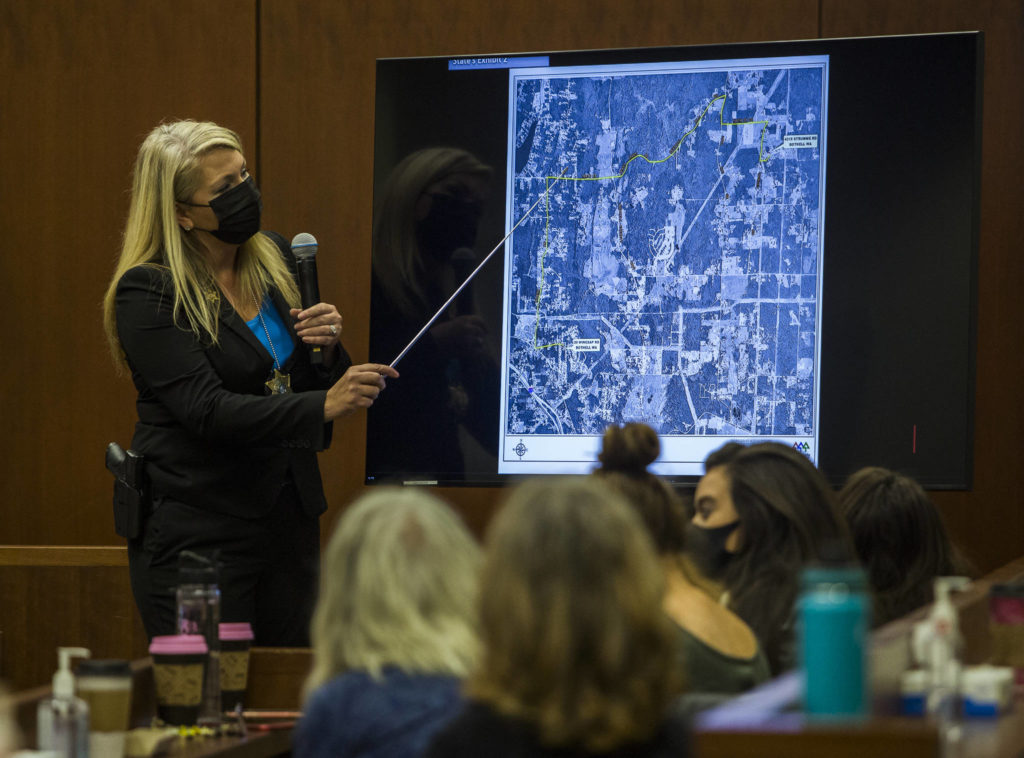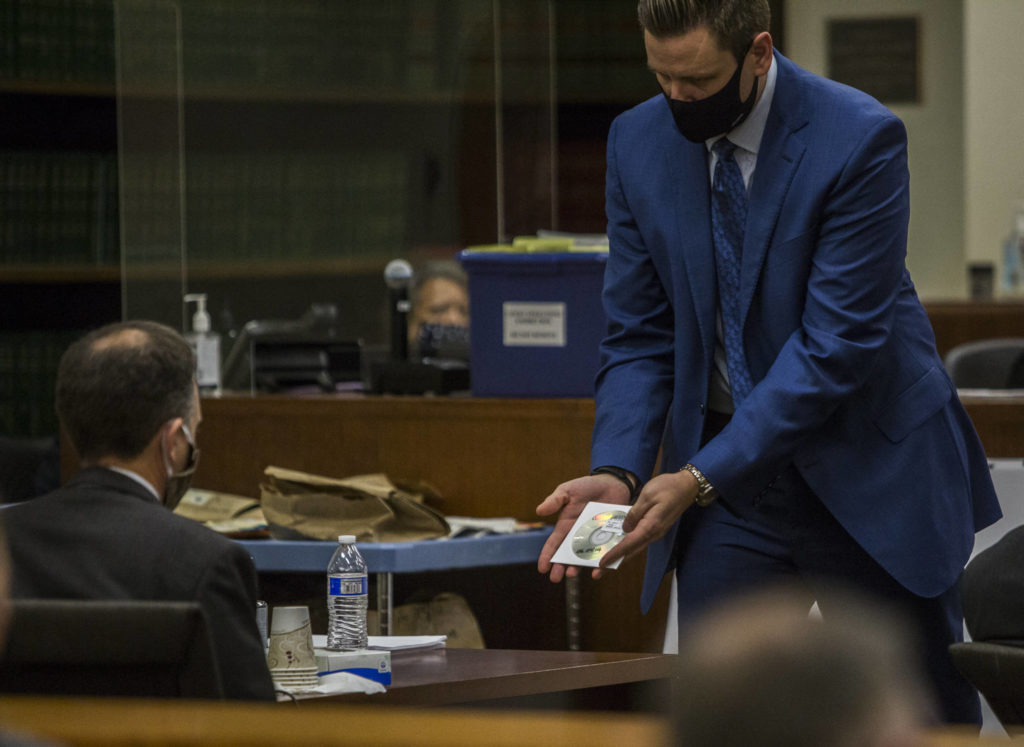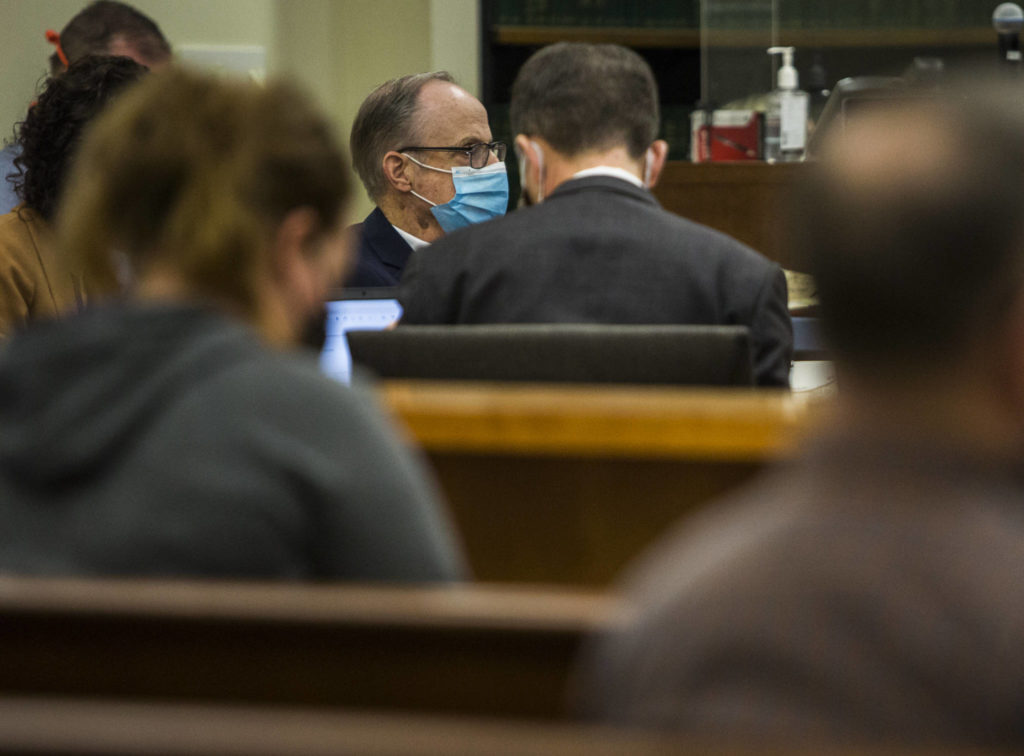EVERETT — With the final piece of evidence presented by prosecutors in the 1972 killing of Jody Loomis, jurors heard the defendant’s own voice.
“When it’s all over and done with, the trial and all that, I’m going to be in prison,” Terrence Miller told his wife of 43 years in a phone call recorded from jail. “This is not a winnable case. That’s the thing.”
“I don’t like to hear that — ” she said.
“I know, Mama, but that is, that is what — that’s the way it is,” he said. “This is not a winnable case. This is a DNA case, and they have an extremely strong case. You’re not going to beat it.”
A jury began deliberating Friday to decide if those were the words of a guilty man who had finally been caught or an innocent man fearing a wrongful conviction. The murder trial was 48 years in the making.
The Snohomish County Courthouse has been the scene of two weeks of testimony in the long-unsolved killing of Loomis, 20, who grew up near Bothell. It’s the second time Snohomish County detectives have used forensic genealogy — a new tool for criminal investigations that combines DNA evidence with public ancestry databases— to track down a murder suspect and bring him to trial decades later.
Prosecutors acknowledged the entire case essentially boils down to one piece of evidence: a semen stain on a St. Moritz “waffle-stomper” boot, size 5½, which Loomis borrowed from her sister on Aug. 23, 1972.
“Any one of us might be convinced that we would be found guilty in the face of DNA evidence, even if we knew we were innocent,” defense attorney Laura Martin said in her closing argument Friday. “Might you, too, believe that you would end up in prison because a DNA case seems unwinnable?”
Miller’s fear was that he would be convicted, not that he was guilty, according to his defense. His DNA on a boot is not proof of murder, Martin said.
At the time of his arrest in 2019, Miller was a retired heavy equipment operator who liked to bowl and golf, “a normal guy,” his defense attorney said. He ran a ceramics shop with his wife in Edmonds. The couple kept a stack of newspapers to shred for packing their wares. Months-old editions of The Daily Herald about the other local genetic-genealogy case were among them. The defense argued it was a coincidence.
Miller, now age 78, lived in Edmonds his entire adulthood, including the summer of 1972. He did not testify. Martin asked jurors to put themselves in the defendant’s place, trying to recall where he was on that summer day over half a lifetime ago.
“What kind of explanation could you possibly offer now?” she said. “How could you know where you were or how that could happen? How could you know?”
That warm sunny afternoon, Loomis borrowed her sister’s back-to-school boots and pedaled her bike toward a horse stable about 6 miles northeast of her family’s home on Winesap Road. She only made it halfway. Around 5:30 p.m., a young couple drove up a secluded dirt track and found a mostly nude woman — a stranger — dying from a gunshot wound to the temple, according to their testimony. They rushed Loomis to the nearest hospital in a tiny Saab Sonett, in such a hurry they did not pause to dress her. She was pronounced dead on arrival.
An autopsy suggested the killer fired a .22-caliber round at a downward angle and left Loomis to die north of Penny Creek Road, now known as Mill Creek Road. Sheriff’s detectives believed she had been raped. Evidence suggested she was trying to get dressed, and there was a patch of dirt stuck to her skin beneath her panties, a sign that she was in a serious hurry to flee the man who assaulted her, deputy prosecutor Craig Matheson said.
Over the past week, Miller’s defense has questioned the reliability of the forensic work that points to the defendant. Swabs taken at an autopsy and other potentially illuminating evidence — such as her socks — were lost over the years. Early on, the boots were sent to an FBI lab to be examined, using much-less-sensitive forensic technology of the 1970s. Apparently, nobody saw a matted stain on an edge of the left boot, and it was returned to the sheriff’s office.
In recent years, when detectives have re-examined the case, they found little documentation of who handled certain pieces of evidence, including the boots, in the early days of the investigation. This was a time when deputies often handled evidence without gloves and gave virtually no thought to DNA. The defense told jurors it may make sense that records and evidence had gone missing in such an old investigation.
“But here’s the thing,” Martin said. “Mr. Miller is charged with murder, a very, very serious crime, and you cannot give them a pass — not in a case like this, not in any criminal case. It’s when juries give the state a pass that people get wrongfully convicted. You have to hold them to their very heavy burden.”
She asked the jury to consider the possibilities.
Since even the FBI didn’t notice the stain, could it be that it wasn’t there in 1972?
Could it have shown up later because evidence was contaminated? Were the boots sitting next to some other evidence? Who handled them? For how long?
“Don’t forget,” Martin said, “that is the evidence against Mr. Miller.”
Loomis had borrowed the brand-new boots from her 12-year-old sister without asking. The defense noted that was a strange choice, since the boots weren’t very practical for a bike ride, and even less so for a horse stable. Neighbor Linda Hook testified that Loomis showed up at her door sometime in the hours before the killing. According to what Hook recalled on the witness stand, Loomis invited her to ride horses. Hook declined because she was packing for a move to California. Then Loomis pedaled away on her bike.
It doesn’t take hours to ride 3 miles, Martin argued. So where had Loomis been from noon to evening?
In 2008, Snohomish County sheriff’s cold case detective Jim Scharf sent evidence for new testing to a Washington State Patrol crime lab. A forensic scientist saw the tiny stain without a microscope. A DNA profile was extracted and used to rule out potential suspects.
A decade later, the semen sample was analyzed again by Parabon Nanolabs so it could be compared to people looking for distant relatives on public ancestry sites. An Oregon genealogist’s research led detectives to the Miller family, and then Terry Miller.
Undercover police trailed him in unmarked cars until he threw out a paper cup at a casino. It was seized and came back as an apparent match for DNA on the boot. Later, the match was confirmed when detectives got a warrant to take swabs directly from Miller.
The defense accused the forensic scientist who procured the original sample of “sloppy” work: diluting a chemical compound during lab work in a way that it could hide contamination; allegedly failing to have work double-checked by a supervisor; and allegedly covering up results showing his DNA contaminated both boots.
“The point is that this sloppiness, this carelessness, calls into question the reliability of their testing,” Martin said. “And the problem is that the unchecked, unreliable, sloppy testing is the foundation of all of the forensic evidence in this case.”
Prosecutors countered that does not change the fact it was Miller’s sperm.
After the state rested its case this week, the defense called no witnesses. An attorney read a brief agreed-upon statement detailing how a detective had searched Miller’s electronics but found nothing relevant to the case. With that, the defense rested without calling any witnesses.
In arguments Friday, the defense proposed two alternate theories.
The dirt road was popular with hunters, so maybe Loomis was shot by a stray bullet.
“Is that reasonable?” deputy prosecutor Bob Langbehn asked in rebuttal. “If that’s true, how did his sperm get on that boot?”
A second defense theory was that Walter Morris, the man who found Loomis, played some role in the killing. He owned a .22-caliber rifle. The teenager with whom he was having an affair, Cathy Gogal, testified that Morris wanted to go target shooting with her that day. Morris gave different stories. At one point, he said he went there to “park.” He also told attorneys months ago that he went there to pick berries. Morris died while the case awaited trial.
Years earlier, detectives had obtained a DNA sample from Morris’ estranged son, a Snohomish County sheriff’s deputy who testified in the murder trial. It ruled out anyone from the deputy’s paternal line. However, the defense questioned that conclusion: Morris was never conclusively proven through DNA to be the man’s biological father, and detectives never actually tested Morris.
Both sides agreed that Miller did not know Loomis.
The Edmonds man was the father of five girls. He divorced three times before marrying his current wife, who helped bail him out of jail last year. Jurors did not hear about past allegations that Miller sexually abused children, or that he was convicted of lewd conduct in 1968. Miller also confirmed to police that he had molested a preteen girl in the mid-1970s. Prosecutors deferred the case in 1978.
After his arrest in the murder, longtime friend Barbo Kulle asked Miller if he had actually done it.
“In the universe of words,” Matheson said in his closing argument, “the defendant chose these: He didn’t want to talk about it, but he thought with the DNA, he probably wouldn’t be coming home, and that it was a ‘dark time’ in his life.”
The same friend testified that he had never seen Miller get mad at anybody. The “dark time,” the defense argued, was a reference to their past divorces, not the crime.
“Don’t let them fool you,” Martin said.
Jurors deliberated for about four hours Friday. Superior Court Judge David Kurtz sent them home for the weekend, and instructed them to resume their discussions Monday.
Correction on Monday, Nov. 9: Details were corrected about issues with old evidence in the case, including that certain articles of clothing were actually retained, not lost.
Caleb Hutton: 425-339-3454; chutton@heraldnet.com. Twitter: @snocaleb.
Talk to us
> Give us your news tips.
> Send us a letter to the editor.
> More Herald contact information.
